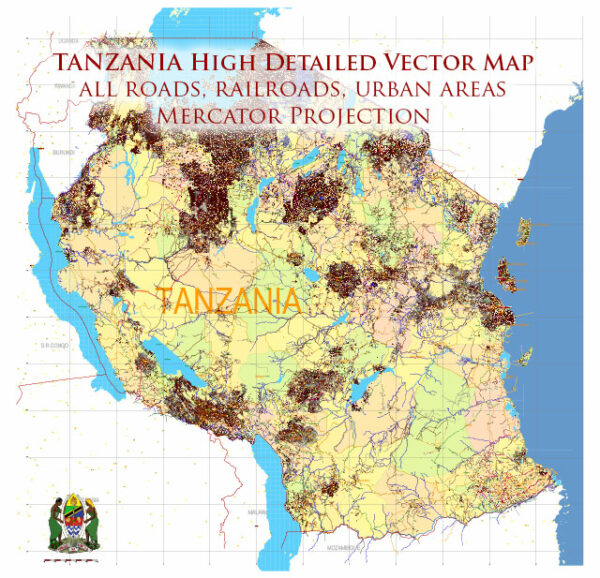Tanzania Vector Road and Street Maps in Adobe Illustrator, PDF, and other vector formats
For publishing, design, printing, media, publications, arts, projects, presentations, for architects, designers, and builders, business, logistics.
Tanzania, officially known as the United Republic of Tanzania, is a country located in East Africa. Here is a brief overview:
Capital and Major Cities:
- Capital: Dodoma (official capital), Dar es Salaam (largest city and major port)
- Other Major Cities: Arusha, Mwanza, Zanzibar City
Population:
- Tanzania has a population of over 60 million people, making it one of the most populous countries in East Africa.
Languages:
- Swahili and English are the official languages. Swahili is widely spoken and serves as a lingua franca, facilitating communication among the diverse ethnic groups.
Ethnic Groups:
- Tanzania is home to numerous ethnic groups, including the Sukuma, Chaga, Haya, and Zaramo, among others. The population is characterized by a rich cultural diversity.
Geography:
- Tanzania is known for its diverse landscapes, including the Serengeti National Park, Mount Kilimanjaro (the tallest peak in Africa), and the Zanzibar Archipelago.
- It shares borders with Kenya, Uganda, Rwanda, Burundi, the Democratic Republic of the Congo, Zambia, Malawi, Mozambique, and the Indian Ocean.
Wildlife and Conservation:
- The country is renowned for its wildlife and is home to various national parks and conservation areas. The Serengeti is famous for the annual migration of wildebeest and other animals.
- Tanzania is also home to the Ngorongoro Conservation Area and the Selous Game Reserve.
History:
- Tanzania gained independence from British and German colonial rule in the early 1960s. Julius Nyerere, the first president, played a key role in the nation’s early post-independence history.
Politics:
- Tanzania operates as a unitary presidential republic. The Chama Cha Mapinduzi (CCM) party has been the dominant political party since independence.
Economy:
- Agriculture is a significant contributor to the economy, employing a large portion of the population. Cash crops include coffee, tea, and tobacco.
- Tanzania has been experiencing economic growth, and tourism is a vital sector due to its natural attractions.
Culture:
- The culture of Tanzania is diverse and influenced by the various ethnic groups. Traditional dances, music, and art are integral parts of the cultural heritage.
- Zanzibar, known for its historical Stone Town, has a distinct cultural identity with Arab, Persian, Indian, and European influences.
Tourism:
- Tanzania is a popular tourist destination, attracting visitors for its safaris, Mount Kilimanjaro climbs, and idyllic beaches on the Zanzibar Archipelago.
- The Serengeti National Park and Ngorongoro Crater are UNESCO World Heritage Sites.


 Author: Kirill Shrayber, Ph.D.
Author: Kirill Shrayber, Ph.D.